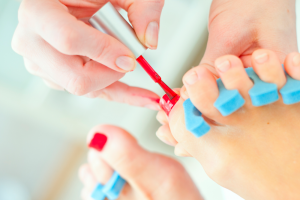Beauty Myth Busted Nails Don’t Need to Breathe, But Taking Polish Breaks Is Still a Must
Needing to let your nails ‘breathe’ between manicures and pedicures is only a myth, but here’s why taking polish breaks is still necessary.
A spicy debate has been heating up the beauty world, and it has nothing to do with whether or not the damn dress is white or blue. Nope, this one involves the age-old saying that it’s necessary to take breaks between manicures and pedicures to allow your nails to “breathe.” Some experts say that mothers everywhere are right: Nails most definitely need to breathe. But others say that nails are incapable of breathing, so there’s no need to halt your next manicure or pedicure. Funny enough, they’re both right — albeit not in the way you may think.
Nails Cannot “Breathe”
Mothers and housewives everywhere have always said that your nails need to breathe. Even Real Housewife of New York City Bethenny Frankel forgoes colorful salon mani/pedis from time to time to allow her nails to get a little oxygen. But it’s time to nail the lid shut on the age-old beauty myth that nails can actually breathe, because let’s face it: They can’t breathe, meaning nails do not need to breathe.
The nail plate that makes up the hard, polish-able area of your fingernails and toenails is made up of non-living keratin (just like your hair). Because it’s not alive, it cannot feel pain, and it cannot breathe. However, all of the components of your fingernails and toenails do require oxygen for healthy cells, which it all receives via blood through tiny blood vessels. Painting your nails does not interfere with this process, so wearing or not wearing polish isn’t a factor in your nail’s ability to receive oxygen.
But Nails DO Need Polish Breaks
Even though nails don’t need to “breathe,” they do need periodic breaks from polish for many reasons, including:
- Frequently removing nail polish with acetone nail polish remover can dry out the nail, causing it to crack, peel, separate and become brittle. Not only is this unattractive, the unhealthy condition and ridging leaves your nails more susceptible to bacterial and fungal infections. Those who use gel polishes are particularly at risk of having super dry nails, as gel removal requires extra time and scrubbing with the acetone.
- Leaving nail polish on for long periods of time can lead to a condition called keratin granulation, which celebrity manicurist Jin Soon Choi says is rough, white patches on the nail that form when old polish is removed and ends up taking superficial layers of the nail with it.
- Nail discoloration can occur from pigments in polishes, so frequently avoiding nail color for short periods of time (two to three weeks) can help cut down on yellowing — as can applying a protective base coat each and every time you paint your nails.
And In Case You Doubt It, Nails CAN Be Beautiful Without Polish
It might seem scary to let your nails go bare, but we’ll let you in on a little secret that will perhaps make you breathe a little easier: Your hands and feet can still give off a sense of glamour sans-polish. All it takes is some good quality cuticle oil to help moisturize, gently pushing the cuticles back with a cuticle pen, a little buffing to boost sheen, and voila: healthy, naturally shiny nails that give colorful manicures a run for their money. You can also try one of these pedicures, sans nail polish.
Notice concerning medical entries:
Articles having medical content shall serve exclusively for the purpose of general information. Such articles are not suitable for any (self-) diagnosis and treatment of individual illnesses and medical indications. In particular, they cannot substitute for the examination, advice, or treatment by a licensed physician or pharmacist. No replies to any individual questions shall be effected through the articles.





